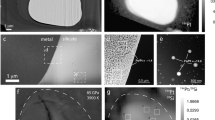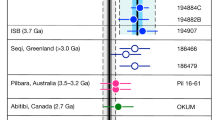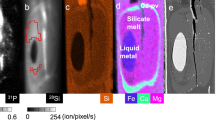Abstract
The abundances of the highly siderophile elements as well as their relative proportions1 in the mantle deviate from those predicted by equilibrium partitioning between metal and silicate during the formation of the Earth’s core. This discrepancy is generally explained by invoking the addition of a late veneer of extraterrestrial material to the mantle after core formation was complete2. Recently reported partition coefficients for gold, platinum and palladium3,4,5 could result in mantle abundances consistent with equilibrium partitioning. However, whether these results can be extrapolated to all highly siderophile elements, and thereby preclude the need for a late veneer, remains to be verified. Here we use high-temperature experiments to determine the metal–silicate partition coefficients for osmium, iridium and gold. On the basis of our estimates, equilibrium partitioning during core formation can explain the observed concentration of gold in the mantle, but not that of osmium and iridium. We conclude that not all highly siderophile elements were affected by core formation in the same way, and that the abundances of elements such as osmium and iridium require the addition of a late veneer.
This is a preview of subscription content, access via your institution
Access options
Subscribe to this journal
Receive 12 print issues and online access
$259.00 per year
only $21.58 per issue
Buy this article
- Purchase on Springer Link
- Instant access to full article PDF
Prices may be subject to local taxes which are calculated during checkout


Similar content being viewed by others
References
Becker, H. et al. Highly siderophile element composition of the Earth’s primitive mantle: Constraints from new data on peridotite massifs and mantle xenoliths. Geochim. Cosmochim. Acta 70, 4528–4550 (2006).
Kimura, K., Lewis, R. S. & Anders, E. Distribution of gold and rhenium between nickel–iron and silicate melts: Implications for the abundance of siderophile elements on the Earth and Moon. Geochim. Cosmochim. Acta 38, 683–701 (1974).
Danielson, L., Sharp, T. & Hervig, R. L. 36th Lunar and Planetary Science Conference Abstr. 1955 (Lunar and Planetary Institute, 2005).
Cottrell, E. & Walker, D. Constraints on core formation from Pt partitioning in mafic silicate liquids at high temperatures. Geochim. Cosmochim. Acta 70, 1565–1580 (2006).
Righter, K., Humayun, M. & Danielson, L. Partitioning of palladium at high pressures and temperatures during core formation. Nature Geosci. 1, 321–323 (2008).
Rubie, D. C., Nimmo, F. & Melosh, H. J. Formation of Earth’s core. Treatise on Geophys. 9, 51–90 (2007).
Rubie, D.C et al. Mechanisms of metal–silicate equilibration in the terrestrial magma ocean. Earth Planet. Sci. Lett. 205, 239–255 (2003).
Nimmo, F. & Agnor, C. B. Isotopic outcomes of N-body accretion simulations: Constraints on equilibration processes during large impacts from Hf–W observations. Earth Planet. Sci. Lett. 243, 26–43 (2006).
Wanke, H. & Dreibus, G. Chemical composition and accretion history of terrestrial planets. Phil. Trans. R. Soc. A 325, 545–557 (1988).
O’Neill, H. St. C. The origin of the Moon and the early history of the Earth—a chemical model. Part 2: The Earth. Geochim. Cosmochim. Acta 55, 1159–1172 (1991).
Righter, K., Drake, M. J. & Yaxley, G. Prediction of siderophile element metal/silicate partition coefficients to 20 GPa and 2800 ∘C: The effects of pressure, temperature, oxygen fugacity and silicate melt and metallic melt compositions. Phys. Earth Planet. Inter. 100, 115–134 (1997).
Wood, B. J., Walter, M. J. & Wade, J. Accretion of the Earth and segregation of its core. Nature 441, 825–833 (2006).
Borisov, A. & Palme, H. Solubility of iridium in silicate melts: New data from experiments with Ir10Pt90 alloys. Geochim. Cosmochim. Acta 59, 481–485 (1995).
Ertel, W. et al. Solubilities of Pt and Rh in haplobasaltic silicate melt at 1300 ∘C. Geochim. Cosmochim. Acta 63, 2439–2449 (1999).
Ertel, W. et al. The solubility of rhenium in silicate melts: Implications for the geochemical properties of rhenium at high temperatures. Geochim. Cosmochim. Acta 65, 2161–2170 (2001).
Borisov, A. & Palme, H. Experimental determination of the solubility of Au in silicate melts. Mineral. Petrol. 56, 297–312 (1996).
O’Neill, H. St. C. et al. Experimental petrochemistry of some high siderophile elements at high temperatures and some implications for core formation and the mantle’s early history. Chem. Geol. 120, 255–273 (1995).
Meisel, T et al. Osmium isotopic compositions of mantle xenoliths: A global perspective. Geochim. Cosmochim. Acta 65, 1311–1323 (2001).
Brandon, A. D., Walker, R. J. & Puchtel, I. S. Platinum–osmium isotope evolution of the Earth’s mantle: Constraints from chondrites and Os-rich alloys. Geochim. Cosmochim. Acta 70, 2093–2103 (2006).
Murthy, V. R. Early differentiation of the Earth and the problem of mantle siderophile elements: A new approach. Science 253, 303–306 (1991).
Capobianco, C. J., Jones, J. H. & Drake, M. J. Metal–silicate thermochemistry at high temperature—magma oceans and the excess siderophile problem of the Earth’s upper mantle. J. Geophys. Res. 98, 5433–5443 (1993).
Holzheid, A. et al. Evidence for a late chondritic veneer in the Earth’s mantle from high pressure partitioning of palladium and platinum. Nature 406, 396–399 (2000).
Ertel, W. et al. Experimental study of platinum solubility in silicate melt to 14 GPa and 2273 K: Implications for accretion and core formation in Earth. Geochim. Cosmochim. Acta 70, 2591–2602 (2006).
Borisov, A. & Walker, R. J. Os solubility in silicate melts: New efforts and results. Am. Mineral. 85, 912–917 (2000).
Fortenfant, S. S. et al. Oxygen fugacity dependence of Os solubility in haplobasaltic melts. Geochim. Cosmochim. Acta 70, 742–756 (2006).
Brenan, J. M., McDonough, W. F. & Ash, R. An experimental study of the solubility and partitioning of iridium, osmium and gold between olivine and silicate melt. Earth Planet. Sci. Lett. 237, 855–872 (2005).
Borisov, A., Palme, H. & Spettel, B. Solubility of palladium in silicate melts: Implications for core formation in the earth. Geochim. Cosmochim. Acta 58, 705–716 (1994).
Ohtani, E. & Yurimoto, H. Element partitioning between metallic liquid, magnesiowustite and silicate liquid at 20 GPa and 2500∘C: A secondary ion mass spectrometric study. Geophys. Res. Lett. 23, 1993–1996 (1996).
Rose, L. A. et al. Effect of pressure, temperature and oxygen fugacity on the metal–silicate partitioning of Te, Se, and S: Implications for earth differentiation. Geochim. Cosmochim. Acta 73, 4598–4615 (2009).
Yokoyama, T. et al. Low osmium solubility in silicate at high pressures and temperatures. Earth Planet. Sci. Lett. 279, 165–173 (2009).
Acknowledgements
J.M.B. gratefully acknowledges research and facilities support from the Natural Sciences and Engineering Research Council of Canada. W.F.M. gratefully acknowledges support from NASA Cosmochemistry grant NNX08AH76G and NSF grant No. 0739006. We are grateful to R. Ash for help with some of the laser-ablation analyses.
Author information
Authors and Affiliations
Contributions
J.M.B. carried out the experiments, and acquired the major element and some of the trace element data. W.F.M. acquired most of the trace element data. Both authors contributed to the research, data interpretation and manuscript preparation.
Corresponding author
Supplementary information
Supplementary Information
Supplementary Information (PDF 1382 kb)
Rights and permissions
About this article
Cite this article
Brenan, J., McDonough, W. Core formation and metal–silicate fractionation of osmium and iridium from gold. Nature Geosci 2, 798–801 (2009). https://doi.org/10.1038/ngeo658
Received:
Accepted:
Published:
Issue Date:
DOI: https://doi.org/10.1038/ngeo658
This article is cited by
-
Geochemical models of core–mantle differentiation
Acta Geochimica (2022)
-
Late veneer and the origins of volatiles of Earth
Acta Geochimica (2022)
-
Cretaceous Meteorite Impact-Induced Initial Subduction: Records of highly Siderophile Element Abundances and Re-Os Isotopes in Ophiolites
Journal of Earth Science (2022)
-
Reconciling metal–silicate partitioning and late accretion in the Earth
Nature Communications (2021)
-
Ruthenium isotope vestige of Earth’s pre-late-veneer mantle preserved in Archaean rocks
Nature (2020)



